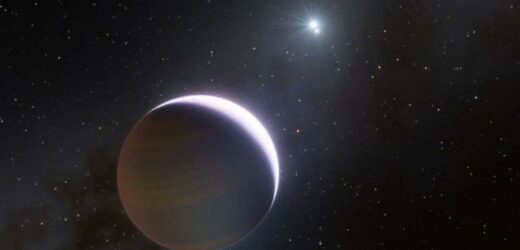European Space Observatory finds new planet
We use your sign-up to provide content in ways you’ve consented to and to improve our understanding of you. This may include adverts from us and 3rd parties based on our understanding. You can unsubscribe at any time. More info
Located some 325 light-years from Earth, the exoplanet was unexpectedly discovered with the aid of the European Southern Observatory’s (ESO’s) Very Large Telescope (VLT). The powerful instrument snapped an image of the planet orbiting a massive star in b Centauri (HIP 71865) at 100 times the distance between Jupiter and the Sun. The b Centauri system is a stellar binary, meaning it consists of two stars orbiting one another.
One of these stars is estimated to be at least six times as massive as our lonely Sun.
According to Markus Janson, an astronomer at Stockholm University, Sweden, and the first author of the new study, this is a particularly thrilling discovery for astronomers.
Until now, scientists have never seen evidence of a planet orbiting more than three times the mass of our Sun.
The new exoplanet has been named b Centauri (AB)b or b Centauri b.


It is about 10 times as massive as Jupiter, making it one of the biggest planets astronomers have ever discovered.
He said: “Finding a planet around b Centauri was very exciting since it completely changes the picture about massive stars as planet hosts
The findings were published on Wednesday in the journal Nature.
The main star in b Centauri is a so-called B-type star that is more than three times as hot as our Sun.
European Space Observatory discusses ‘Stranger Exoplanets’
Because of its scorching temperatures, the star emits large amounts of X-ray and ultraviolet radiation.
Its large mass and heat should have precluded the formation of a planet by having a “strong impact” on the gas in its surrounding.
In theory, the bigger a star is, the more high-energy radiation it produces, the faster the surrounding material evaporates.
Dr Janson said: “B-type stars are generally considered as quite destructive and dangerous environments, so it was believed that it should be exceedingly difficult to form large planets around them.”


But this appears not to be the case in b Centauri and the new discovery indicates planets can form in pretty inhospitable environments.
Gayathri Viswanath, a PhD student at Stockholm University and study co-author, said: “The planet in b Centauri is an alien world in an environment that is completely different from what we experience here on Earth and in our solar system.
“It’s a harsh environment, dominated by extreme radiation, where everything is on a gigantic scale: the stars are bigger, the planet is bigger, the distances are bigger.”
The planet b Centauri b was found to fly around b Centauri around an exceptionally wide orbit – 100 times as far as Jupiter is from the Sun.
The astronomers speculate this large separation could be key to the planet’s survival.
Dr Janson said: “It will be an intriguing task to try to figure out how it might have formed, which is a mystery at the moment.”
The discovery was made possible thanks to the Spectro-Polarimetric High-contrast Exoplanet REsearch instrument (SPHERE) mounted on the VLT.
The instrument previously allowed the ESO telescope to image many other planets, including the world’s first-ever image of two planets circling a Sun-like star.
Source: Read Full Article


